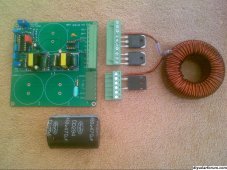sun walker
New Member
"Scaling up in current is much more practical and easier to do than scaling up in voltage."Buck converters can be made to be very efficient, but only if the voltage step down ratio is fairly low, say 2:1 or 3:1
I was planing on having the 9 & 8 panel's as a mix of series & parallel, using the panel spec's the 9 mix (3 in parallel as 3 in series) = 114v 39A.
But it sounds like least is best, 3 in series only is ok, though in aiming for a sweet spot in cable use
3 strings (2 of 6 panels + 1 of 5 panels) would be nice, if realistic for your design on the 17 panels?
Ok, so if the panels likely spec's are ~332W, 38V, 11A, & if 17 panels in 3 strings is ok?
then for the 6 stringed panels what would be best
(3 in series as 2 groups in parallel) =1992W/96V
= ~21A
or (6 in series) = 1992W/192V =10A
(192v on a tin roof & a bit >3:1 buck)
The odd # 5 panels is tough & can only be in series = 1660W/160v = 11A
for the buck that's a 3:1
I hope my numbers add up.
So which combo, if any, of the above are suitable?
Next step will be the Gerber file, no problem if you don't have a copy?
I can draw it up & make it available to any body who may want to use it, if that's ok?
Once I've done that I should be able to run simulation test's, I've found a number of online sites for this & they can make the PCB, & even add the electronic parts, although I'll probably add the mosfet's, capacitor's & chokes etc, I like the easy mosfets replacement option in your design, plus it keeps it small & light for post.
As I say this is all knew to me, its a real learning curve, so let me know if I'm mistaken in any of the above. All in all a fun project.





